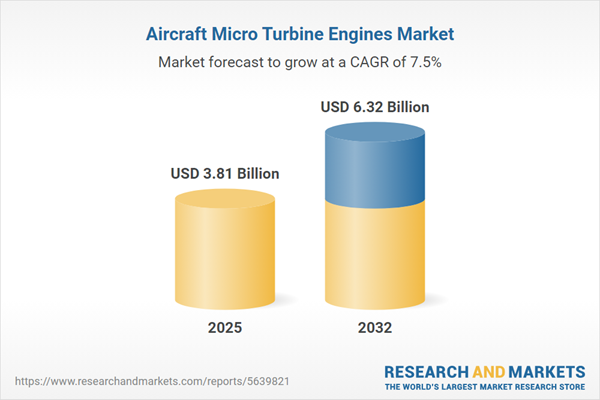Speak directly to the analyst to clarify any post sales queries you may have.
The aircraft micro turbine engines market is evolving rapidly as organizations adapt to new regulatory frameworks, operational demands, and the need for advanced technology solutions. As leaders prioritize compliance and efficiency, micro turbine engines emerge as vital assets for power generation, operational reliability, and adaptable infrastructure in dynamic environments.
Market Snapshot: Aircraft Micro Turbine Engines Market Overview
The global aircraft micro turbine engines market stands at USD 3.55 billion in 2024, projected to rise to USD 3.81 billion in 2025 and reach USD 6.32 billion by 2032, reflecting a CAGR of 7.46%. This growth is driven by increased investments in advanced propulsion systems, propelled by breakthroughs in material science, modular engineering, and digital maintenance. Industry front-runners are leveraging these advancements to boost reliability and address the growing complexity of global compliance standards. As markets mature, micro turbine engines are recognized as integral to strategic planning, enabling organizations to secure operational continuity and adapt to changing sector demands.
Scope & Segmentation
- Applications: Micro turbine engines are leveraged across aerospace, automotive, marine, military, energy, and oil and gas sectors, delivering energy management flexibility for diverse operational requirements and ever-evolving scenarios.
- Engine Types: Dual shaft, regenerative, and single shaft turbines provide organizations with tailored operational profiles to address specific technical needs and mission-critical applications.
- Fuel Types: Compatibility with gaseous and liquid fuels supports seamless integration and sustainability initiatives, simplifying decarbonization efforts and logistical fuel management across multiple networks.
- End Users: Energy providers, manufacturers, defense agencies, and public sector organizations rely on micro turbine engines for robust infrastructure, reliable performance, and preparedness for high-demand or mission-critical operations.
- Distribution Channels: Direct collaboration with original equipment manufacturers and technology specialists enables streamlined integration, lifecycle management, and optimization of engine assets to meet rigorous operational objectives.
- Geographic Regions: Adoption is concentrated in the United Kingdom, Germany, select Gulf states, and China, with growing regional expansion throughout the Americas, EMEA, and Asia-Pacific, each shaped by local regulatory landscapes and sector demand for advanced propulsion technologies.
- Key Companies: Leading market players include Honeywell International Inc., Safran Helicopter Engines, Collins Aerospace Inc., Williams International Co., Advanced Microturbine Technology B.V., Bladon Jets Limited, JetCat GmbH, and Turbotech SARL, recognized for their technological benchmarks and industry innovation.
Key Takeaways for Senior Decision-Makers
- Micro turbine engines help organizations quickly adapt to changing compliance demands and evolving energy distribution models, ensuring strategic resilience as markets shift.
- Modern digital monitoring systems and additive manufacturing processes support greater asset transparency and faster maintenance cycles, enhancing reliability across the engine lifecycle.
- Development of hybrid propulsion, integrating hydrogen and battery technologies, is expanding application potential and positioning organizations for future environmental standards.
- Flexible procurement and diversified supply strategies reduce vulnerability, enabling operational leaders to secure access to essential components even in times of global market volatility.
- Partnerships among manufacturers, technology providers, and research bodies expedite certification and deployment, bringing compliant solutions to market efficiently.
- Expanding micro turbine engine applications into manufacturing and utilities sectors provides organizations with new revenue opportunities and supports adaptability beyond aviation markets.
Tariff Impact: Navigating Regulatory Adjustments
Shifts in tariff structures, particularly in the United States, have spurred organizations to reshape supply chains by prioritizing nearshoring and building robust domestic networks. This approach improves cost control and stabilizes procurement, shielding operations from unpredictable international pricing. The use of formalized contracts has become a cornerstone of risk management, helping procurement leaders maintain continuity and safeguard margins amid ongoing global regulatory fluctuations.
Technological & Operational Transformation in the Aircraft Micro Turbine Engines Market
Digital platforms and real-time analytics are transforming operational oversight, providing proactive compliance management and enhanced asset monitoring. Additive manufacturing accelerates the transition from prototyping to commercial production, reducing market entry timelines for new engine models. By adopting digital twin methodologies and advanced combustion analytics, organizations achieve greater predictability and alignment with regulatory expectations. Modular architecture promotes swift adaptation to new customer requirements and evolving technology standards in aerospace and related sectors.
Methodology & Data Sources
The report draws from executive-level interviews, focused literature reviews, and detailed examination of technical and regulatory trends. Insights are validated through benchmarking exercises, supply chain mapping, and scenario modeling to ensure actionable conclusions for senior stakeholders in the aircraft micro turbine engines sector.
Why This Report Matters
- This report provides actionable guidance for deploying advanced micro turbine engines and building compliance-ready technology systems in complex operational environments.
- Organizations will be equipped to refine procurement strategies, adopt emerging technologies, and maintain resilience amidst dynamic regulatory and market trends.
- Decision-makers gain forward-looking perspectives, assisting them in planning for sector shifts and long-term competitive positioning.
Conclusion
This report offers strategic clarity for leaders navigating global shifts in the aircraft micro turbine engines market, empowering agile and informed decisions that enhance organizational resilience and performance.
Additional Product Information:
- Purchase of this report includes 1 year online access with quarterly updates.
- This report can be updated on request. Please contact our Customer Experience team using the Ask a Question widget on our website.
Table of Contents
3. Executive Summary
4. Market Overview
7. Cumulative Impact of Artificial Intelligence 2025
Companies Mentioned
The companies profiled in this Aircraft Micro Turbine Engines market report include:- Honeywell International Inc.
- Safran Helicopter Engines
- Collins Aerospace Inc.
- Williams International Co.
- Advanced Microturbine Technology B.V.
- Bladon Jets Limited
- JetCat GmbH
- Turbotech SARL
Table Information
| Report Attribute | Details |
|---|---|
| No. of Pages | 197 |
| Published | October 2025 |
| Forecast Period | 2025 - 2032 |
| Estimated Market Value ( USD | $ 3.81 Billion |
| Forecasted Market Value ( USD | $ 6.32 Billion |
| Compound Annual Growth Rate | 7.4% |
| Regions Covered | Global |
| No. of Companies Mentioned | 9 |









